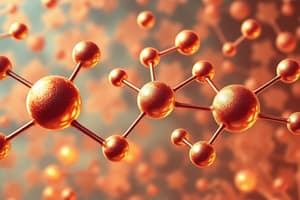Podcast
Questions and Answers
What is the polarity of CO2?
What is the polarity of CO2?
- Charged
- Non-polar (correct)
- Polar
- Neutral
What is the shape of SO2?
What is the shape of SO2?
- Linear
- Tetrahedral
- Bent (correct)
- Trigonal Planar
What type of bond polarity exists in NH3?
What type of bond polarity exists in NH3?
Polar
What is the polarity of NOBr?
What is the polarity of NOBr?
Is NOCl polar or non-polar?
Is NOCl polar or non-polar?
What is the polarity of CH4?
What is the polarity of CH4?
What is the shape of H2O?
What is the shape of H2O?
What is the polarity of POCl3?
What is the polarity of POCl3?
Is CCl4 a polar or non-polar molecule?
Is CCl4 a polar or non-polar molecule?
What is the shape of SO3?
What is the shape of SO3?
What is the polarity of BF3?
What is the polarity of BF3?
What is the polarity of COCl2?
What is the polarity of COCl2?
Is SiH4 polar or non-polar?
Is SiH4 polar or non-polar?
What is the shape of H2S?
What is the shape of H2S?
Is CH2Cl2 a polar or non-polar molecule?
Is CH2Cl2 a polar or non-polar molecule?
Is CH3Br polar or non-polar?
Is CH3Br polar or non-polar?
Flashcards are hidden until you start studying
Study Notes
Carbon Dioxide (CO2)
- CO2 has polar C-O bonds due to differing electronegativities but is overall non-polar.
- The linear molecular shape allows bond dipoles to cancel each other out.
Sulfur Dioxide (SO2)
- SO2 has polar S-O bonds; the molecule is overall polar due to its bent shape.
- There are 3 electron repulsions, with a lone pair on sulfur affecting the bond arrangement.
Ammonia (NH3)
- NH3 has a trigonal pyramidal shape due to one lone pair, despite being tetrahedral initially.
- Contains polar N-H bonds resulting in an overall polar molecule due to asymmetrical charge distribution.
Nitrosyl Bromide (NOBr)
- NOBr adopts a bent shape with one lone pair, leading to asymmetrical charge distribution.
- The molecule is overall polar, as dipoles do not cancel.
Nitrosyl Chloride (NOCl)
- NOCl also has a bent shape due to a lone pair, resulting in a polar molecule.
- Asymmetrical charge distribution causes the cancellation of dipole effects.
Methane (CH4)
- CH4 displays a tetrahedral shape and symmetric charge distribution; therefore, it is non-polar.
- The bond dipoles cancel out due to symmetrical arrangement.
Water (H2O)
- H2O has a bent shape with two lone pairs, leading to overall polarity.
- The asymmetrical charge distribution results in a slightly negative end and a slightly positive end.
Phosphoryl Chloride (POCl3)
- POCl3 features a tetrahedral geometry, exhibiting an overall polar nature.
- The molecular structure has asymmetrical charge distribution.
Carbon Tetrachloride (CCl4)
- CCl4 is tetrahedral with symmetric charge distribution, making it a non-polar molecule.
- Dipoles from C-Cl bonds cancel out due to symmetrical arrangement.
Sulfur Trioxide (SO3)
- SO3 has a trigonal planar shape with symmetrical charge distribution, resulting in non-polarity.
- The uniform arrangement allows for dipole cancellation.
Boron Trifluoride (BF3)
- BF3 features a trigonal planar shape and symmetric charge distribution, making it non-polar.
- The arrangement results in cancellation of dipole moments.
Carbonyl Dichloride (COCl2)
- COCl2 has a trigonal planar shape with asymmetrical charge distribution leading to it being polar.
- Polar bonds arise from differences in electronegativity between C, Cl, and O.
Silane (SiH4)
- SiH4 has a tetrahedral shape with polar Si-H bonds, which are symmetrically arranged, rendering the molecule non-polar.
- The symmetry allows the dipoles to cancel out.
Hydrogen Sulfide (H2S)
- H2S exhibits a bent shape due to two lone pairs, resulting in overall polarity.
- Polar S-H bonds lead to an asymmetrical charge distribution within the molecule.
Dichloromethane (CH2Cl2)
- CH2Cl2 has a tetrahedral shape with polar C-Cl bonds; however, the charge distribution is asymmetric and gives a polar character to the molecule.
- The different polarities of C-H and C-Cl bonds result in cancellation issues.
Bromoform (CH3Br)
- CH3Br is tetrahedral and features polar bonds where C-Br is more polar than C-H.
- As dipoles do not cancel out, the molecule is overall polar due to its asymmetrical arrangement.
Studying That Suits You
Use AI to generate personalized quizzes and flashcards to suit your learning preferences.




